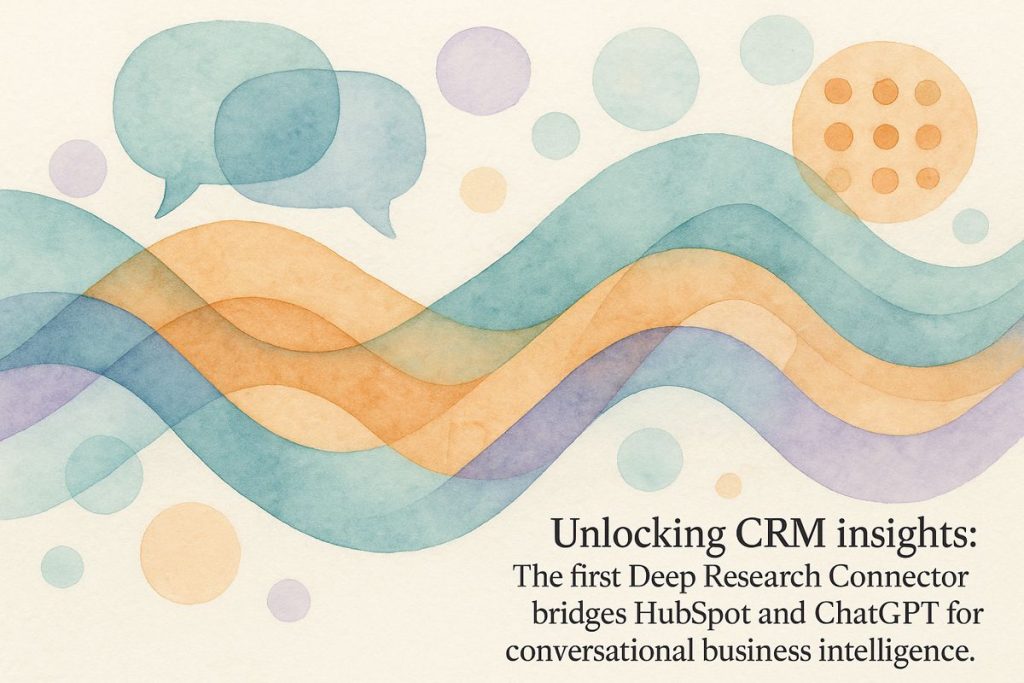The HubSpot Deep Research Connector for ChatGPT lets anyone easily ask questions and get answers from their company’s CRM data using simple language, just like chatting over coffee. With strong security, it means teams don’t need tech skills to find insights, automate tasks, or spot trends—they just type their questions and ChatGPT fetches the answers. Marketers, sales, and support folks can all save time and make smarter moves without wrestling with messy reports or tricky code. It’s like giving your CRM a friendly, helpful voice. This new tool is stirring up excitement because it truly puts data power in everyone’s hands.
What is the HubSpot Deep Research Connector for ChatGPT and how does it benefit users?
The HubSpot Deep Research Connector for ChatGPT allows users to seamlessly access, analyze, and interact with CRM data using natural language. With secure, permission-based integration, teams can quickly gain actionable insights, automate tasks, and democratize analytics—no SQL or technical expertise required.
I. The Connector Nobody Saw Coming (But Everyone Wanted)
Picture this: it’s early June 2025, and HubSpot, never one to rest on its laurels, quietly drops a little bombshell into the CRM universe—a Deep Research Connector for ChatGPT. I’ll admit, when I first read the changelog blip over my morning espresso (beans courtesy of a slightly overzealous subscription service), I nearly spilled it on my keyboard. Why all the fuss? Well, this isn’t just another API handshake. This is the first CRM Deep Research Connector to appear in ChatGPT’s official registry, built atop a remote MCP server, and stamped with HubSpot’s signature paradox: innovation wrapped in familiar, scalable security. I had to stop and ask myself: is this the dawn of an actual, living, breathing, conversational CRM?
The answer, it turns out, is a resounding “maybe, but wow, what a start.” HubSpot’s move links its CRM data—contacts, companies, deals, tickets, and those annoyingly complex associations—directly into ChatGPT, which means anyone (with the right permissions) can now interrogate their business’s beating digital heart in plain English. No more deciphering hyperspectral dashboards or prodding SQL queries until something useful falls out. Just talk to your data.
Of course, privacy zealots can unclench; the connector honors all existing HubSpot permissions, so your junior sales rep isn’t about to peek into the CEO’s private pipeline. As Smith Digital put it, access is as granular as it is necessary. And yes, the aroma of cautious optimism was thick in the air.
II. Talking to Your Data—And Actually Getting Answers
Let’s get concrete. The real marvel here isn’t just the technical handshake—it’s the way analytics leap from the dusty shelves of SQL sorcery right into natural conversation. I’m reminded of the first time my grandmother tried a touchscreen phone: a little confusion, a lot of awe, and, by the end, a litany of questions about “what else can it do?”
Now, imagine a marketing manager sipping cheap office coffee, typing: “Who converted quickest last quarter?” ChatGPT, plugged into the Deep Research Connector, sifts and sorts through HubSpot’s structured palimpsest, then responds, not with a cryptic export file, but with a conversational, actionable insight. It’s almost eerie—like you’re communing with your CRM’s subconscious.
This opens doors for non-technical users, brass tacks. Suddenly, actionable insights aren’t just for the SQL whisperers—anyone with a question can join the party. MarTech called it “democratizing analytics,” and, for once, the buzzword isn’t entirely misplaced. I felt a genuine jolt of excitement (rare, before the second cup of coffee).
And for those thinking, “but is it easy to set up?”—well, yes and no. The initial connection ritual requires a HubSpot Super Admin (the dark wizards of SaaS permissions) or someone with App Marketplace clout, as HubSpot’s own documentation dryly assures. After that, it’s rinse-repeat for the rest of the team. The process is linear, almost suspiciously so. A faint whiff of predictability in a world of digital entropy.
III. From Marketer to Sales Star: How Teams Actually Use It
Let’s drop into real-world use cases—the lifeblood of any integration worth its salt (or, in this case, its cloud storage). Marketing teams can now perform cohort analysis or persona discovery without running post-mortem reports at midnight. “Which cohort generated the highest MRR growth in Q1?”—that’s a real question, and now, a real answer, thanks to the connector’s fusion of OpenAI and HubSpot. HubSpot’s newsroom crows about building lookalike audiences on-the-fly and triggering automated nurture campaigns. It’s not marketing alchemy, but it’s close.
Sales, meanwhile, can slice and dice accounts by revenue, industry, or even tech stack (take that, old-school CRM filters!). Want to prioritize deals with a closing probability over 60% that have stagnated for more than two weeks? That’s a mouthful, but ChatGPT doesn’t flinch. Simple.ai’s summary echoes what my own team saw: time spent on pipeline triage drops, and focus shifts to the deals that actually matter.
Even customer success gets a seat at the table. The connector can sniff out silent churn risks—accounts gone ghost for 90 days, say—or surface seasonal patterns in support tickets (nobody enjoys the cacophony of Q4 renewals). And, with integrations like Breeze Customer Agent, support teams ride out ticket tsunamis without losing their collective minds. If only it could make the coffee, too…
IV. Industry Ripples, Privacy Shields, and a Glimpse Ahead
So, what’s the industry upshot? Turns out, HubSpot was reading the room—according to their own 2025 survey, more than 75% of customers were already monkeying around with ChatGPT before the connector even launched (Destination CRM. See more at monexa.ai/blog/hubspot-s-strategic-ai-leap-chatgpt-integration-an-HUBS-2025-06-05.
